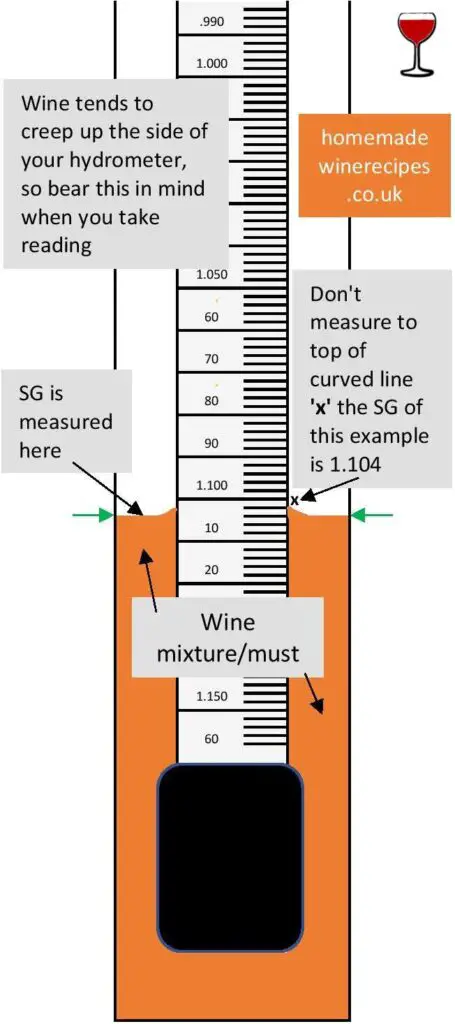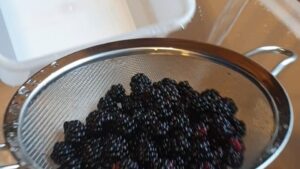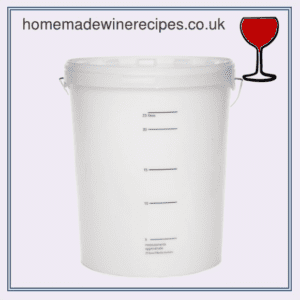How To Use A Wine Hydrometer For Best Results
The basic idea of a wine hydrometer is that it floats higher if the liquid being tested is heavier and it floats lower if it’s lighter. Because sugar is heavier than water the higher the hydrometer floats the more sugar is in your mix, so it’ll float highest at the beginning of the process when the sugar is at its highest and it’ll float lowest at the end when most of the sugars in your wine have been converted into alcohol.
There are normally three common scales listed on your hydrometer, ‘specific gravity‘ ‘potential alcohol‘ and the ‘Brix‘ scale. It’s the ‘specific gravity’ we’re going to concentrate on here. Specific gravity or S.G is the most common scale used by home winemakers and is a scale you’ll see listed in most home wine recipes, it revolves around the weight of water. If you place a hydrometer in pure water, its S.G reading will be 1.000.
So take your reading with your hydrometer just before you’re ready to start fermentation (before adding wine yeast), when your must is full of sugar it should be around 1.070 to 1.110 depending on the recipe and the type of wine you’re making, now make a record of this reading as you’ll need it later. At the end of the process when most of the sugar is converted into alcohol the S.G reading should be below 1.000 which is a little less than water, because alcohol is lighter than water.
The correct way of calculating the S.G (specific gravity) is…
If the original S.G was 1.110 and then the reading after fermentation completes was 0.996 the ABV = 15.12951 this is arrived at…
1.110-0.998=0.112 x 132.715 = 14.86408 ABV (alcohol by volume)

| Starting S.G | 1.110 | |
| Finished S.G | 0.996 | – (minus) |
| = (equals) | 0.112 | now do calc |
| 0.114 x 131.25 = | 15.12951 | ABV (alcohol by volume) |
Another way of hopefully arriving at the same result is. The ‘potential alcohol’ scale shows you how much alcohol could be made from the amount of sugar that’s currently in your must, so if my reading right now is around 15.2% potential alcohol this means if all the sugar that’s in the mix right now gets converted into alcohol my finishing wine would be 15.2% alcohol that’s why we take readings at the beginning and the end of our process so we can accurately calculate the alcohol in our finished wine. We do this by subtracting the last reading from our first reading and see how much alcohol was produced so if you have 15.2% potential alcohol to start and 0.7% potential alcohol at the end your wine is 14.5% alcohol.
So now you appreiciate that a Hydrometer is a cool piece of kit for the more professional winemakers amongst us, but hopefully the keen ameters now see that the hydrometer can be your friend as well. If used correctly we can label our wines with (or just know) the alcoholic strength of our homemade wine offering. Be aware that the maximum stregnth of your wine will never exceed 17% as alcohol is killed at that level of alcohol (or from 10%). When you understand how the hydrometer works you can see how the hydrometer suggests how much more sugar is required to reach your desired alcohol level.
Use the chart below to assist calculations.
| Specific Gravity S.G | Sugar already present lb/oz | Sugar already present kg | Potential Alcohol % |
|---|---|---|---|
| 1.040 | 13oz | 0.36 | 5.4 |
| 1.045 | 15oz | 0.42 | 6.1 |
| 1.050 | 1lb 1oz | 0.48 | 6.8 |
| 1.055 | 1lb 3oz | 0.53 | 7.4 |
| 1.060 | 1lb 5oz | 0.59 | 8.1 |
| 1.065 | 1lb 7oz | 0.65 | 8.8 |
| 1.070 | 1lb 9oz | 0.70 | 9.5 |
| 1.075 | 1lb 11oz | 0.76 | 10.1 |
| 1.080 | 1lb 13oz | 0.82 | 10.8 |
| 1.085 | 1lb 15oz | 0.88 | 11.4 |
| 1.090 | 2lb 1oz | 0.94 | 12.1 |
| 1.095 | 2lb 3oz | 0.99 | 12.8 |
| 1.100 | 2lb 5oz | 1.05 | 13.4 |
| 1.105 | 2lb 7oz | 1.11 | 14.1 |
| 1.110 | 2lb 9oz | 1.16 | 14.7 |
| 1.115 | 2lb 11oz | 1.22 | 15.4 |
| 1.120 | 2lb 13oz | 1.28 | 16.0 |
| 1.125 | 2lb 15oz | 1.33 | 16.8 |







